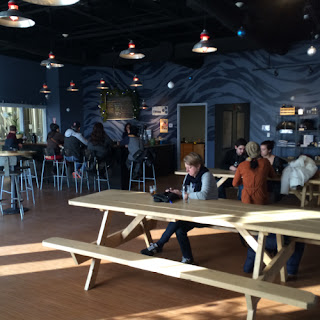
We all know of at least one, probably more, home brewer who successfully took his or her game up to the commercial level. And it helps to start early to get the necessary experience. Andreas "Andy" Gänstaller, who has been brewing beer for almost 40 years, started at the age of 15 -- is that early enough for you? Andy is the owner/brewer of the 35hl/30bbl Gänstaller Bräu located in the small Franconia village of Schnaid, near Bamberg.
Andy began brewing professionally in 2007. Early in his beer life he was inspired by the Weltenburg Kloster brewery, and counted wheat beers among his favorite styles. After working for others, he established the Gänstaller brewery to produce a wide range of traditional German, non-traditional German, and uber-traditional German beers. He's well known for his Smoked Doublebock Beer, the 9.6% Affumicator. But his most popular brew is the Zoigel, an unfiltered, malty Kellerbier.
 |
| B.R., Andy, and Bob at Greenpoint Brewing/Dirck the Norseman. |
Zoigel is a regional dialect (Oberpfalz) variation of the word "zeige", meaning to show, or a sign. In the old days, a pub or guesthouse would have an arrow hanging out front, and if there was beer to be had, the arrow pointed up. If not, then down. And after having tasted Andy's incredibly delicious, fresh Zoigel on tap at Threes and Jimmy's No. 43 when he recently visited, you can be sure that a skyward pointing arrow is much preferred!
Gänstaller sells their beer in their own local pub/restaurant, the Zoiglstube located in Strassgiech a few kilometers down the road from the production brewery in Schnaid, and at a few other local pubs. Much of their production is sold outside of Germany, in Italy, Sweden, Denmark, Norway, Finland, and now the United States.
 |
| Enduro, a coffee Berliner Weisse, a creation of Greenpoint Brewing. |
A few things set the Gänstaller brewery apart. First, they use traditional decoction mashing, which, while utilized by many smaller artisanal brewers, is still not the norm. A bit more uniquely, though, especially for a German brewery, they cool the post-boil wort in an enormous cool ship, allowing the open air to bring down the temperature of the unfermented beer so that live yeast may be pitched in to begin fermentation. Lastly, Andy uses many ale recipes (pale ales, IPAs, stouts) but exclusively employs lager yeast. He often will ferment his ale-style beers with the lager yeast at higher temperatures. And, of course, he makes plenty of great traditional lagers, bocks, and Märzens.
 |
| Greenpoint's Jeff, Erik, Andy, Chris, and importer Joel. |
 |
| Andy's wife Manuala, Joel, Greg, and Andy in the Threes brewhouse. |
 |
| Andy, Threes' Greg, importer B.R., Threes' brewer Joel, and importer Joel. |















































